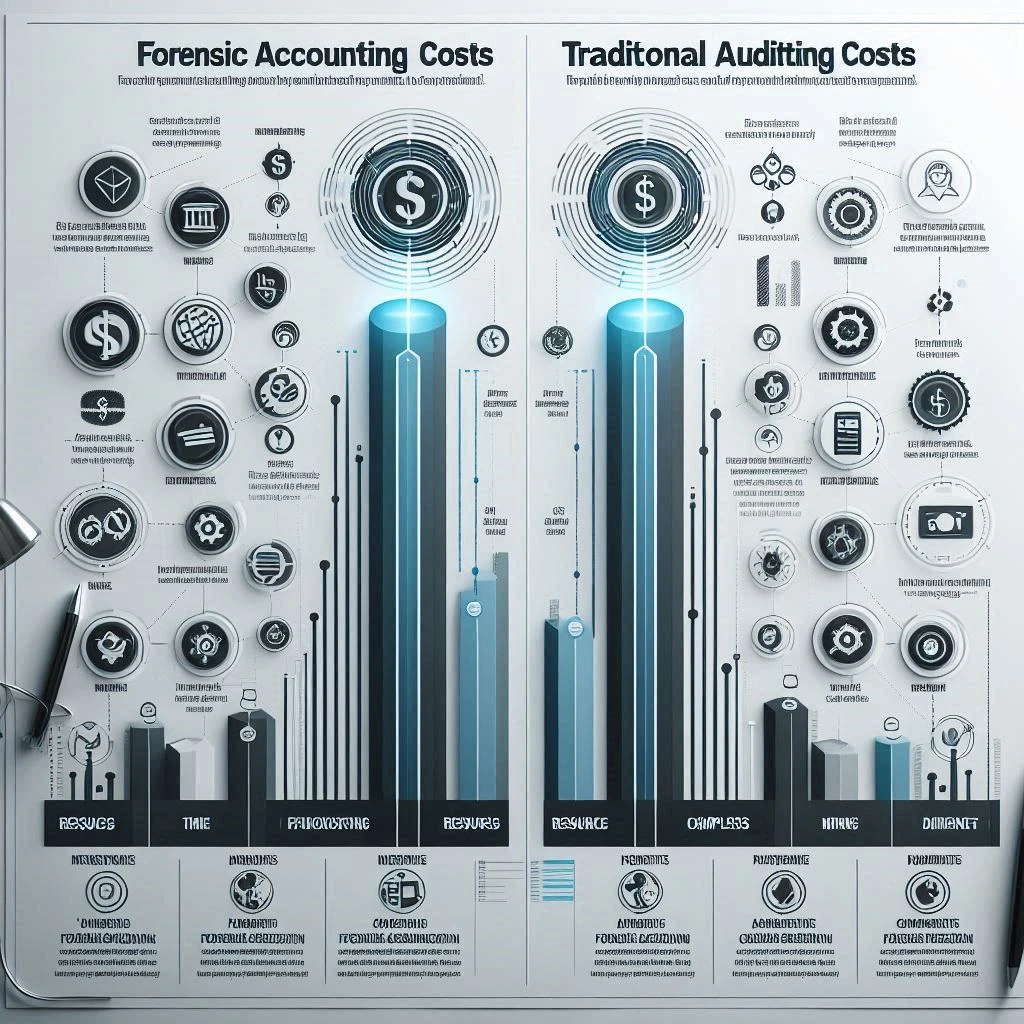In the realm of financial oversight, both forensic accounting and traditional auditing play crucial roles, albeit with distinct focuses and methodologies. Understanding the costs associated with these practices, including how much does a forensic accountant cost, is essential for internal auditors and financial analysts who aim to make informed decisions regarding resource allocation and risk management.
Forensic Accounting: Definition and Role
Forensic accounting is a specialized field that combines accounting, auditing, and investigative skills to analyze financial records and uncover fraud or criminal financial activity. This discipline is particularly vital in cases involving financial crimes such as fraud, embezzlement, and money laundering, as well as in legal disputes like divorce proceedings and child custody battles. Forensic accountants employ various techniques to detect discrepancies and provide expert testimony in court, making their role integral to both legal and financial sectors [9].
Traditional Auditing: Definition and Focus
In contrast, traditional auditing primarily focuses on evaluating an organization’s financial statements to ensure compliance with applicable laws, regulations, and policies. The objective is to identify material errors and prevent fraud, thereby providing stakeholders with a level of assurance regarding the accuracy and reliability of financial reporting. Traditional audits are generally more routine and systematic, emphasizing compliance and accuracy over investigative analysis [6][8].
Importance of Understanding Costs
The costs associated with both forensic accounting and traditional auditing can vary significantly based on several factors, including the complexity of the task, the expertise of the professionals involved, and the geographic location of the services. Forensic accountants typically charge between $200 and $300 per hour, with some specialized services costing even more. In contrast, traditional auditing fees can range from $500 to $1,500 per day, depending on the size and complexity of the organization being audited [11][15].
Understanding these costs is crucial for internal auditors and financial analysts as they evaluate the potential return on investment for each type of service. While forensic accounting may appear more expensive upfront, its ability to uncover financial discrepancies and provide legal support can lead to significant long-term savings and risk mitigation for organizations [10][12][13].
Both forensic accounting and traditional auditing serve essential functions in financial oversight, but they do so through different lenses. By comprehensively understanding the costs and benefits associated with each practice, professionals can make more informed decisions that align with their organizational goals and compliance requirements.
Understanding the Cost Structure of Forensic Accounting
When considering the costs associated with forensic accounting, it is essential to understand the various factors that influence pricing and how these compare to traditional auditing practices. Forensic accountants are specialized professionals who analyze financial records to uncover fraud or criminal financial activity, and their services can be significantly different in cost and scope compared to traditional auditors.
Typical Hourly Rates for Forensic Accountants
Forensic accountants typically charge between $150 and $500 per hour, depending on their level of expertise and the complexity of the case at hand. More experienced professionals, such as senior forensic partners or certified fraud examiners (CFE), often command higher rates, with some firms charging upwards of $300 to $500 per hour for specialized services [10].
Several factors influence these rates:
- Level of Expertise: More experienced forensic accountants tend to charge higher fees due to their advanced skills and knowledge [1].
- Geographic Location: Costs can vary significantly based on the region, with metropolitan areas generally seeing higher rates compared to smaller towns or rural areas [12].
- Market Demand: The demand for forensic accounting services can also affect pricing, with higher demand potentially leading to increased rates [11].
Scope of Work and Its Impact on Total Costs
The total cost of hiring a forensic accountant is heavily influenced by the scope of work required. Key considerations include:
- Complexity of Cases: More intricate and time-consuming investigations will naturally incur higher costs. For instance, cases involving extensive financial fraud or embezzlement may require more hours of analysis, thus increasing the overall expense [1].
- Duration of Investigations: The length of time needed to complete an investigation can vary widely. A typical fraud analysis engagement may span 50 to 70 hours, leading to total costs ranging from $8,000 to $21,000 depending on the hourly rate charged [15].
Additional Costs to Consider
In addition to the hourly rates of forensic accountants, there are several other costs that organizations should be aware of:
- Legal Fees: If the forensic accounting work is related to legal proceedings, additional legal fees may be incurred for representation or consultation [2].
- Data Analysis Tools: Forensic accountants often utilize specialized software and tools for data analysis, which can add to the overall cost of the engagement.
- Expert Testimonies: In cases that go to court, the costs may also include fees for expert testimonies, which can be substantial depending on the complexity of the case and the expert’s reputation.
While the costs associated with hiring a forensic accountant can be significant, they are often justified by the potential benefits of uncovering financial discrepancies and ensuring compliance. Understanding the cost structure and the factors that influence pricing can help internal auditors and financial analysts make informed decisions when considering forensic accounting services.
Cost Structure of Traditional Auditing
When considering the financial implications of traditional auditing services, it is essential to understand the typical fee structures, the factors influencing these costs, and any additional expenses that may arise due to compliance and regulatory requirements.
Typical Fee Structures for Traditional Audits
Traditional auditing services generally employ two primary fee structures:
- Fixed Fees: Some auditing firms offer fixed fees for specific services, which can provide clients with a clear understanding of costs upfront. This model is often used for routine audits where the scope of work is well-defined.
- Hourly Rates: Many auditors charge by the hour, with rates typically ranging from $500 to $1,500 per day, depending on the complexity of the organization being audited and the auditor’s level of expertise [5]. This structure can lead to variable costs, especially if the audit requires more time than initially anticipated.
Factors Influencing Audit Costs
Several factors can significantly impact the overall cost of traditional auditing services:
- Size of the Organization: Larger organizations often incur higher audit costs due to the increased complexity and volume of transactions that need to be reviewed. The scale of operations can necessitate more extensive audit procedures, leading to higher fees.
- Industry: Different industries have varying regulatory requirements and complexities. For instance, industries such as finance and healthcare may face stricter compliance standards, which can increase the cost of audits due to the need for specialized knowledge and additional procedures.
- Geographic Location: The cost of auditing services can also vary based on geographic location. In metropolitan areas with a high cost of living, audit fees may be higher compared to those in smaller towns or rural areas [12]. This disparity is often due to the increased demand for services and the higher operational costs faced by firms in urban settings.
Additional Costs Related to Compliance and Regulatory Requirements
In addition to the basic fees associated with traditional auditing, organizations may encounter additional costs related to compliance and regulatory requirements:
- Compliance Costs: Organizations may need to invest in systems and processes to ensure compliance with various regulations, which can add to the overall cost of auditing. This includes expenses for training staff, implementing new technologies, and maintaining documentation.
- Regulatory Changes: Frequent changes in regulations can lead to increased audit costs as firms may need to adapt their audit procedures to meet new requirements. This can result in additional hours billed by auditors as they navigate the complexities of compliance.
Understanding the cost structure of traditional auditing is crucial for internal auditors and financial analysts. By recognizing the typical fee structures, the factors influencing costs, and the potential additional expenses related to compliance, organizations can better prepare for the financial implications of engaging auditing services.
Comparative Analysis of Costs: Forensic Accounting vs. Traditional Auditing
When evaluating the financial implications of forensic accounting versus traditional auditing, it is essential to understand the cost structures and the value each service provides. Below is a detailed comparison of average costs, a cost-benefit analysis, and illustrative examples to guide internal auditors and financial analysts in making informed decisions.
Average Costs Comparison
Forensic Accounting Costs:
- Forensic accountants typically charge between $150 to $500 per hour, depending on their expertise and the complexity of the case [10][11].
- The total cost for a forensic accounting engagement can range from $3,000 to over $10,000, particularly in cases involving intricate financial investigations such as fraud or embezzlement [2][3].
- In metropolitan areas, costs may be higher due to the increased demand and cost of living, with some firms charging upwards of $500 per hour for specialized services [12][14].
Traditional Auditing Costs:
- Traditional auditing services generally range from $500 to $1,500 per day, influenced by the size and complexity of the organization being audited [5].
- The overall cost for a standard audit can vary significantly, but it is often less than that of forensic accounting, especially for routine compliance audits.
Cost-Benefit Analysis
Forensic Accounting:
- Benefits: Forensic accounting is invaluable in situations involving financial crimes, providing detailed investigations that can uncover hidden assets or fraudulent activities. The insights gained can lead to significant financial recoveries and legal advantages.
- Scenarios for Use: Forensic accounting is particularly beneficial in divorce proceedings, fraud investigations, and cases requiring litigation support. The potential for recovering lost funds or securing favorable legal outcomes often justifies the higher costs [2][15].
Traditional Auditing:
- Benefits: Traditional audits focus on compliance and error prevention, offering a level of assurance that financial statements are free from material misstatement. They are generally more cost-effective for routine financial oversight.
- Scenarios for Use: Organizations typically engage traditional audits for annual financial reporting, regulatory compliance, and internal control assessments. These audits are essential for maintaining stakeholder trust and ensuring operational integrity.
The choice between forensic accounting and traditional auditing should be guided by the specific needs of the organization. Forensic accounting, while more expensive, provides critical insights in complex situations involving financial misconduct. In contrast, traditional auditing serves as a cost-effective solution for routine compliance and operational assessments. Understanding the costs and benefits of each approach enables internal auditors and financial analysts to make strategic decisions that align with their organizational goals.
Benefits Beyond Costs: The Value of Forensic Accounting
When considering the costs associated with forensic accounting, it is essential to look beyond mere dollar amounts and evaluate the unique advantages it offers compared to traditional auditing practices. While the hourly rates for forensic accountants can range from $150 to $500 or more, depending on their expertise and the complexity of the case, the intrinsic benefits they provide can often justify these costs [10][11]. Here are some key points to consider:
- Detailed Fraud Investigations: Forensic accountants specialize in uncovering financial discrepancies and fraudulent activities. Their training allows them to conduct thorough investigations that go beyond the surface-level checks typical of traditional audits. This capability is crucial in identifying and addressing issues such as fraud, embezzlement, and money laundering, which can have devastating financial impacts on organizations [2].
- Risk Mitigation: By employing forensic accounting techniques, organizations can significantly reduce their risk exposure. Forensic accountants not only identify existing fraud but also help in developing strategies to prevent future occurrences. Their insights into financial behaviors and patterns can lead to the implementation of stronger internal controls, ultimately safeguarding the organization’s assets [1][12].
- Insights Beyond Traditional Auditing: Forensic accountants bring a unique perspective that traditional auditors may overlook. Their focus on the details of financial transactions allows them to identify anomalies and trends that could indicate underlying issues. This level of scrutiny can provide organizations with a deeper understanding of their financial health and operational risks, leading to more informed decision-making [6].
- Long-Term Financial Benefits: Investing in forensic accounting can yield significant long-term financial benefits. While the initial costs may seem high, the potential savings from preventing fraud and mitigating risks can far outweigh these expenses. Organizations that proactively engage forensic accountants may find that they save money in the long run by avoiding costly fraud investigations and legal battles [3][13].
While the costs of hiring a forensic accountant can be substantial, the value they bring through detailed investigations, risk mitigation, and unique insights can provide organizations with a robust defense against financial misconduct. The long-term benefits of investing in forensic accounting not only enhance financial integrity but also contribute to a more secure and resilient organizational framework.
Benefits of Traditional Auditing: A Cost Perspective
Traditional auditing plays a crucial role in ensuring the financial integrity of organizations, and its benefits extend beyond mere compliance. Here are some key advantages of traditional auditing, particularly from a cost perspective:
- Regulatory Compliance: One of the primary benefits of traditional auditing is its ability to ensure compliance with applicable laws, regulations, and policies. This compliance not only helps organizations avoid legal penalties but also fosters a culture of accountability and transparency, which is essential for maintaining stakeholder trust. By adhering to regulatory standards, organizations can mitigate the risk of costly fines and reputational damage that may arise from non-compliance [6].
- Stakeholder Trust: Traditional audits provide a substantial level of comfort to stakeholders, including investors, creditors, and regulatory bodies. The assurance that financial statements are free from material misstatements enhances the credibility of the organization. This trust can lead to better financing options, improved investor relations, and potentially lower costs of capital, as stakeholders are more likely to engage with organizations that demonstrate financial reliability [8].
- Cost Savings through Improved Financial Practices: Regular audits can lead to significant cost savings by identifying inefficiencies and areas for improvement within financial practices. By uncovering discrepancies and recommending corrective actions, traditional audits can help organizations streamline operations, reduce waste, and enhance overall financial performance. This proactive approach can ultimately lead to a healthier bottom line, offsetting the costs associated with the audit process itself.
- Routine Nature vs. Specialized Focus: Traditional audits are typically routine and systematic, focusing on material error identification and prevention. This routine nature allows organizations to budget for auditing costs more effectively, as they can anticipate the frequency and scope of audits. In contrast, forensic accounting is specialized and often more complex, focusing on investigating specific financial crimes or irregularities. While forensic accounting can provide valuable insights, it often comes with higher costs due to its intricate nature and the expertise required [1][15].
Traditional auditing offers a range of benefits that can lead to cost savings and enhanced stakeholder confidence. By ensuring regulatory compliance, fostering trust, and identifying areas for financial improvement, traditional audits serve as a vital component of an organization’s financial strategy.
Choosing the Right Approach: Factors to Consider
When deciding between forensic accounting and traditional auditing, internal auditors and financial analysts must evaluate several key factors that can significantly influence the effectiveness and cost-efficiency of their chosen approach. Here are the primary considerations:
1. Nature of the Issue
- Complexity of Financial Matters: Forensic accounting is particularly beneficial when dealing with intricate financial crimes such as fraud, embezzlement, or money laundering. These situations often require specialized skills to analyze financial records and uncover hidden activities, which can justify the higher costs associated with forensic services [10].
- Scope of Investigation: Traditional audits focus on compliance and material error identification, which may suffice for routine financial assessments. However, if the organization suspects fraudulent activities or needs to conduct a detailed investigation, forensic accounting becomes essential [6][15].
2. Budget Constraints
- Cost Variability: The cost of hiring a forensic accountant can range significantly, typically between $150 to $500 per hour, depending on the complexity of the case and the accountant’s expertise [10]. In contrast, traditional auditing services may have a more predictable cost structure, ranging from $500 to $1,500 per day [5]. Organizations must weigh these costs against their budgetary constraints and the potential financial impact of the issues at hand.
- Potential ROI: While forensic accounting may appear more expensive upfront, it can lead to substantial savings by uncovering fraud or financial mismanagement that could result in significant losses. Internal auditors should assess the potential return on investment (ROI) of each service based on the specific circumstances of their organization [13].
3. Industry Regulations
- Compliance Requirements: Different industries have varying regulatory requirements that may necessitate a forensic approach. For instance, sectors with stringent compliance standards may benefit from the detailed investigations provided by forensic accountants, ensuring adherence to legal and ethical guidelines [8][12]. Understanding these regulations can help organizations determine the most appropriate auditing method.
4. Organizational Goals and Risk Appetite
- Alignment with Strategic Objectives: The choice between forensic accounting and traditional auditing should align with the organization’s overall goals. If the organization prioritizes risk management and fraud prevention, investing in forensic accounting may be more suitable [9]. Conversely, if the focus is on routine compliance and financial reporting, traditional auditing may suffice.
- Risk Tolerance: Organizations with a higher risk appetite may opt for traditional audits, which are generally less invasive and less costly. However, those with a lower risk tolerance, particularly in high-stakes environments, may find that the thoroughness of forensic accounting justifies the additional expense [12][14].
The decision between forensic accounting and traditional auditing should be guided by a careful assessment of the nature of the financial issues, budget constraints, industry regulations, and the organization’s strategic goals and risk appetite. By evaluating these factors, internal auditors and financial analysts can make informed choices that not only address their immediate needs but also contribute to the long-term financial health of their organization.
Conclusion: Making an Informed Decision
In the realm of financial oversight, understanding the costs associated with forensic accounting compared to traditional auditing is crucial for internal auditors and financial analysts. Here’s a recap of the main differences in cost and benefits between these two practices:
- Cost Variability: Forensic accountants typically charge between $200 and $500 per hour, depending on their expertise and the complexity of the case, with total engagements often ranging from $8,000 to $21,000 for extensive fraud analyses [10][15]. In contrast, traditional auditing services can range from $500 to $1,500 per day, influenced by the size and complexity of the organization being audited [4]. This significant difference in pricing reflects the specialized nature of forensic accounting, which often involves detailed investigations into financial discrepancies.
- Benefits of Forensic Accounting: While the costs of forensic accounting may be higher, the benefits can be substantial. Forensic accountants are trained to uncover fraud, embezzlement, and other financial crimes, providing insights that can protect an organization from significant losses. Their expertise can be particularly valuable in high-stakes situations, such as divorce proceedings or complex financial disputes, where the stakes are high and the need for accurate financial representation is critical [2].
- Traditional Auditing Advantages: Traditional audits focus on identifying material errors and ensuring compliance with accounting standards, offering a level of assurance that is essential for regulatory purposes [6]. They are generally more cost-effective for routine financial oversight and can help organizations maintain operational integrity without the need for extensive investigative work.
Aligning auditing practices with organizational objectives is paramount. Organizations must assess their specific needs—whether they require the detailed investigative capabilities of forensic accounting or the compliance-focused approach of traditional auditing. This alignment ensures that the chosen auditing method supports the overall strategic goals of the organization.
Before engaging auditing services, it is essential for organizations to conduct thorough assessments of their financial situations and the potential risks involved. This includes evaluating the complexity of their financial records, the likelihood of fraud, and the specific outcomes they wish to achieve. By doing so, internal auditors and financial analysts can make informed decisions that not only address immediate concerns but also contribute to the long-term financial health of the organization.
In conclusion, while forensic accounting may come with higher costs, its potential benefits in uncovering fraud and providing detailed financial insights can outweigh these expenses in certain contexts. Conversely, traditional auditing remains a vital practice for routine financial oversight. Ultimately, the decision should be guided by a careful evaluation of the organization’s unique circumstances and objectives.
Find out more about Shaun Stoltz https://www.shaunstoltz.com/about/
This post was written by an AI and reviewed/edited by a human.



